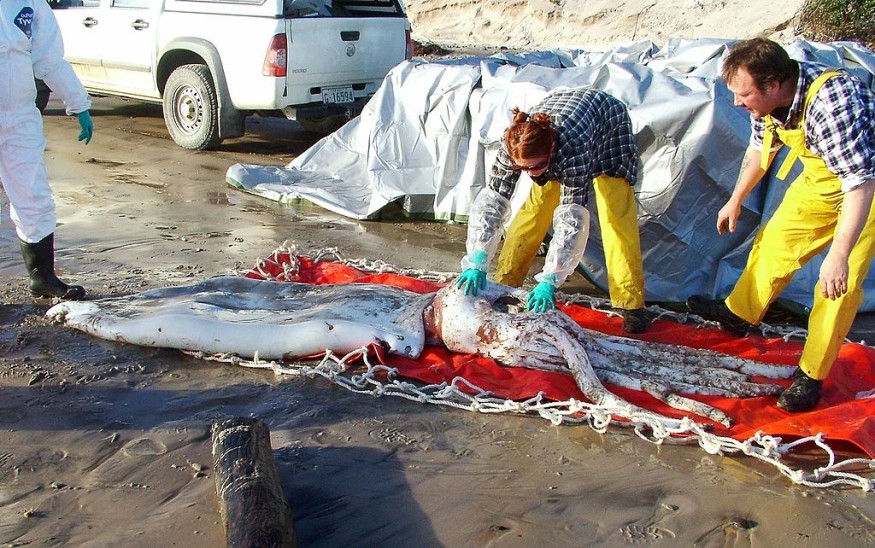A rare giant squid was found dead on a beach in Cape Town, South Africa. A few months ago, a similar incident happened six miles away, MailOnline reported. Tim Dee posted a video and pictures of the giant squid on his Twitter account, showing the fist-sized beak and the squid's big eye.
Giant squids are sea creatures usually found at 980 to 3,280 feet below the ocean's surface. They are one of the largest invertebrates that can reach around 39 to 43 feet for females and 33 feet for males.
Second Giant Squid Carcass Found in Scarborough Beach
The giant squid carcass washed ashore on the rocky shore of Scarborough Beach on Tuesday. News24 reported that it is estimated to have measured nearly 14 feet (4.3 meters) long and is the second to be washed ashore in the region this year.
The first giant squid (Architeuthis dux) recently washed ashore was found six miles (10 kilometers) northwest of Scarborough Beach on Long Beach, Kommetjie, on April 30. It measured roughly 11.5 feet (3.5 meters) long.
According to Smithsonian Magazine, the largest giant squid ever measured was a whopping 43 feet (13 meters) long, and some studies suggest these sea creatures could grow up to 66 feet (20 meters) long.
How Did the Giant Squid Die?
National Oceanic and Atmospheric Administration (NOAA) invertebrate zoologist Mike Vecchione, who is stationed at Smithsonian's National Museum of Natural History in Washington, D.C., told Live Science that the one washed ashore in Scarborough Beach this week is another Architeuthis dux species, although there are bigger species that exist.
Giant squid close ups - wrecked this morning on Scarborough beach, just north of the Cape of Good Hope: pic.twitter.com/m7YqL9H9gQ
— Tim Dee (@TimDee4) August 16, 2022
Vecchione noted that it is difficult to guess how the giant squid died without an examination of its organs. Its arms are broken off and have skin abrasions that may have resulted from the rocky shore. They hypothesize that the squid may have ventured into shallow, near-shore waters to feed but got stuck by a ship's propeller, but this is hard to prove without any witnesses.

This handout photo dated July 10, 2007 from the Tasmania Parks and Wildlife Service shows unidentified members of the Parks and Wildlife Service with a giant squid that was washed up on Ocean Beach, July 10, 2007 near Strahan, Australia
ALSO READ : Record-Breaking Giant Squid Caught in Hawaii, Fisherman Says It Can Make About 100 Plates of Calamari
Previous studies suggest that giant squids come up into shallow water because of diel vertical migration. That means they venture outside their habitat into shallower waters during the evening to feed and then go back to deeper waters during the day.
Officials have gathered some tissue samples from the giant squid carcass in Scarborough Beach and will soon be examined at the Iziko South African Museum, Gregg Oelofse. Scientists could run chemical analyses to detect pollutants and stable isotopes in the water, which will give them hints about the feeding history of the squid.
Additionally, scientists could check the reproductive organs and statoliths of the giant squid to determine how old it was. Statoliths are small mineralized masses inside the sensory organs of a squid's head and accumulate growth rings as they age. Existing literature showed that giant squids could live up to five years old.
Dylan Clarke, a marine scientist and curator at Iziko South African Museum, told News24 that the availability of information on giant squids is poor and mostly based on dead or dying animals that have been washed ashore or captured in nets. The recent sighting adds to the specimens of giant squids at the museum.
Below is Tim Dee's video posted on Twitter of the recent giant squid carcass found in Scarborough Beach:
RELATED ARTICLE: Giant Squid Bigger Than a Toddler Washed Ashore in Cape Town After Similar Massive Creature Was Spotted in Japan
Check out more news and information on the Giant Squid in Science Times.











